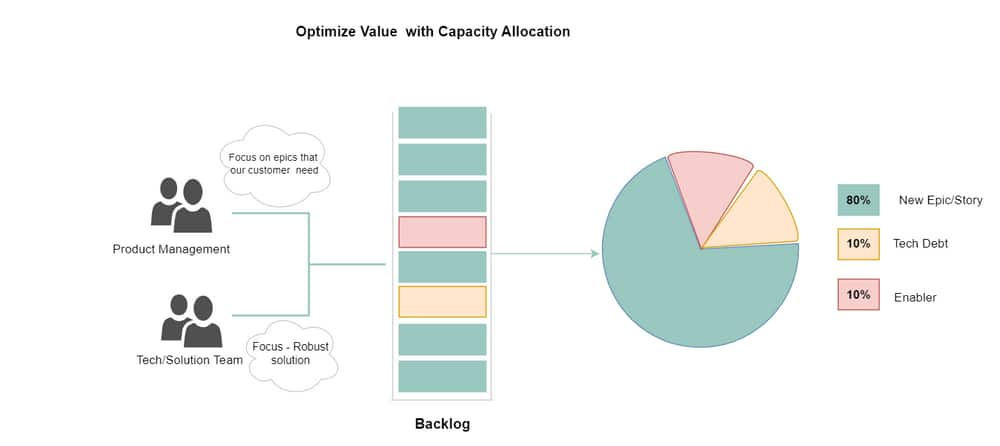Prior to PI Planning, Teams and ART will determine their capacity. First step is to estimate starting capacity, then allocate capacity to type of work. New Epics/Enablers and Tech Debt and Maintenance usually take the most of available capacity. Recommendation is to allocate 80% of available capacity to New Epics, 10%, to Tech Debt and 10% to Enablers, although this can vary by Teams/Squads and ARTs.

Squads could apply one of the two methods Estimate Starting Squad Capacity per iteration depending on their maturity. Method 1 is for newly established squads where velocity is not known or has not stabilized yet. Method 2 is for those squads where velocity is known and stable.
Method 1 – “New Squads”: teams where velocity has not been stabilized
Step 1. For new Squads, start by establishing story points per day with reference to common story points to calculate available capacity. Common Story Points are calculated 1 story point = 6.4 hours
Step 2. Estimate Squad Maximum Capacity Per Person
For each iteration multiply total number of working days by number of working hours per day and divide by 6.4 hours to arrive at the total capacity in story points. Calculate Maximum Starting Capacity as 80% of the Total Story points per Iteration.
| Maximum Capacity per Person (2 Weeks Iteration 10 working days) | ||
|---|---|---|
|
On shore hours |
Offshore hours |
Working hours/Day |
8 |
9 |
Iteration hours / person |
80 |
90 |
Non-working hours |
0 |
0 |
Total Story Points per Iteration |
12 |
14 |
Maximum Starting Capacity (80% story points) |
10 |
11 |
Note: 20% capacity is accounted for scrum events/meetings.
|
||
| Maximum Capacity per Person ( 3 Weeks Iteration 15 working days) | ||
|---|---|---|
|
On shore hours |
Offshore hours |
Working hours/Day |
8 |
9 |
Iteration hours / person |
120 |
135 |
Non-working hours |
0 |
0 |
Total Story Points per Iteration |
18 |
21 |
Maximum Starting Capacity (80% story points) |
15 |
16 |
Note: 20% capacity is accounted for scrum events/meetings.
|
||
Method 1 Example: A team that has three developers, two testers, a Scrum Master, a BSA and a Product Owner, with no scheduled time-off for this iteration.
Maximum Capacity (2 weeks iteration) = 5 Team Members * 16 story points = 80 story points per iteration
Scrum master, BSA and product owner capacity is excluded from iteration capacity.
Step 3. Adjust Squad Maximum Capacity to account for non-working time
Non-working time, e.g., vacation days, holidays, freeze days, etc., need to be accounted for to determine total number of available working hours per iteration. For each person, subtract total of non-working hours from their iteration hours, then divide by 6.4 hours to arrive at the Story Points per Iteration. Estimated Starting Capacity per person is 80% of Story points.
| Estimated Starting Capacity per Person (3 Weeks Iteration) | ||
|---|---|---|
|
On shore hours |
Offshore hours |
Working hours/Day |
8 |
9 |
Iteration hours / person |
120 |
135 |
Non-working hours |
8 (1 day) |
18 (2 day) |
Total Story Points per Iteration |
18 |
18 |
Estimated Starting Capacity (80% story points) |
14 |
15
|
Step 4. To Estimate Squad Starting Capacity, add available capacity in story points, per each team member.
You can use the Capacity Calculation Template to record Squad availability, and arrive at Estimated Starting Capacity per squad. The file is available here.Capacity Calculation Template.xlsx
Method 2 – “Established Squad”: Squad where velocity has stabilized could use their velocity to estimate starting capacity for next iteration. In this method, you don’t need to adjust to 80% of maximum capacity as that is already accounted for in Squads stabilized velocity. However, you need to account for any non-working time. There are multiple ways of doing this, thus it’s best to consult with your team and coaches when you’re ready to apply this method.
Pre-requisites to use this method are:
The Squad has completed at least one PI
Squad Velocity is stabilizing
Squad is using story points.
Approach:
1. Determine how many past iterations velocity to include
2. Add velocity by iteration
3. Add duration in weeks for included iterations
4. Divide total velocity by number of weeks included
5. Multiple velocity per week by number of weeks in the planned iteration
Method 2 Example:
Squad has been performing with similar velocity over the past 4 iterations.
Iteration |
Duration |
Velocity pts |
By week |
1 |
3 weeks |
100 |
33 |
2 |
3 weeks |
95 |
32 |
3 |
3 weeks |
110 |
37 |
4 |
2 weeks |
65 |
33 |
Total |
11 Weeks |
442 |
34
|
To estimate upcoming iteration, take an average value from the past iterations (i.e., add velocity from each iteration, divide by # of iterations). Multiply weekly velocity by the number of weeks in each iteration planned to arrive at Estimated Starting Capacity.




